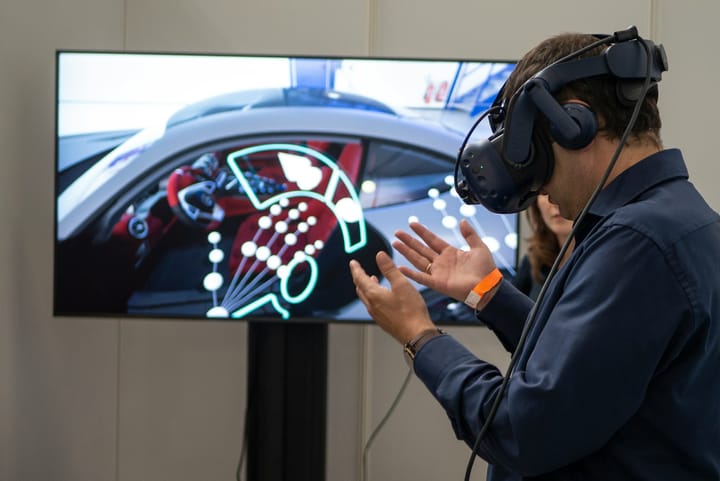10 most remarkable Cutting-Edge Technologies for the near future

The peculiarity of such technologies is that it is always a changing concept. One could think that such technologies were unrealistic. But today we use them and they have become game-changers and tomorrow there will be new cutting-edge technologies. Not long ago, technologies like cloud services, artificial intelligence, or virtual reality were confined to the realm of sci-fi movies. But today, they’re a normal part of many businesses and everyday gadgets. Soon, they’ll be even more common.
What are cutting-edge technologies?
These technologies are the latest and best innovations. They have the power to change entire industries and make our daily lives better.
Cutting-edge technology denotes innovative advancements in a specific industry at a given moment. It defines the forefront of technological progress. The main features of it are originality, outstanding performance, and the prospect to greatly influence our lives.
What were the cutting-edge technologies in 2023?
- AI (functions that provide machine learning, generative artificial intelligence)
- Serverless Computing (moving computing resources to the cloud)
- Low-code (a visual framework that enables faster delivery of apps by minimizing manual coding)
- Natural Language Processing (combines computer linguistics with statistical and machine learning models to help digital devices recognize, understand, and generate text and speech)
- Blockchain (a system of digital ledgers that securely records and verifies transactions shared between computing nodes)
- Microservices (the pursuit of dividing software solutions into various unified microservices rather than creating massive, monolithic programs and services)
So what are the leading cutting-edge technologies of today?
Here is our top 10 list:
1. Homomorphic Encryption
Homomorphic encryption helps organizations to securely share private data without compromising privacy. It facilitates collaboration and computation between two parties without revealing sensitive information. This technology opens up many new possibilities for keeping data safe.
2. Quantum computing
Quantum computing is an advanced technology that uses quantum physics principles to solve complex problems. It recently passed 5,000 qubits, unlocking new computing power.
It is worth reminding that this year, a neuromorphic supercomputer called DeepSouth is scheduled to be activated. This supercomputer can perform 228 trillion synaptic operations per second. It corresponds to the estimated number of operations in the human brain. As quantum computing moves forward, the deployment of neuromorphic supercomputers spotlights the transformative possibility of cutting-edge technologies. This brings us closer to simulating unparalleled complexity and sophistication.
3. Robotics
Interest in this field has surged, with many governments and businesses investing heavily. Robotics involves using robots in a wider range of sectors and services.
Significant advancements have been made in the field of robotics. The AI and machine learning integration has enabled the creation of robots capable of performing tasks with a realism of a high degree. Two standout examples are “Ameca”, a humanoid robot by Engineered Arts, and “Sophia”, a socially intelligent humanoid from Hanson Robotics in Hong Kong.
These robots showcase cutting-edge technology and offer a glimpse into future applications of robotics, including:
- Swarm robotics: Robots working together with humans in agriculture, search-and-rescue, and environmental monitoring.
- Logistical and workforce automation: Robots are addressing Japan’s labor shortages, known as “The 2024 problem,” by assisting in warehouses.
Overall, multimodal robotics has the potential to reshape how we interact with intelligent machines, offering countless options for collaboration and innovation.
4. Augmented Reality (XR)
Virtual reality, augmented reality, and mixed reality are three types of XR. XR is a new technology that merges the digital and physical realms. In 2024, XR is changing entertainment, education, and training simulations. It offers experiences that were once only in science fiction.
The future of XR is in hyper-realistic experiences. These experiences use multisensory transmitters. New technology lets VR feel real. With sensory VR, users can feel the touch, smell, or taste things in a virtual world. This makes the experience more immersive. Consequently, we are heading towards a future of VR where it is increasingly challenging to discern what is real and what is not.
5. 5G expansion and 6G initiatives
In addition to fast download speeds, 5G opens up a world of possibilities for cloud storage. With fast downloads, people can easily store, stream, and share 4k HD video. This changes how people consume and share media. 5G will improve video and audio quality. You’ll see clearer images and hear better audio.
Once this technology becomes common, it will also be integrated into devices other than mobile phones. That will allow us to manage everything from our mobile devices, including our cars, TVs, home appliances, etc.
Research on 6G is already underway. It could offer faster speeds and revolutionize network connectivity.
6. Autonomous weapons
In early December 2023, the International Institute for Strategic Studies in London (IISS) recorded 183 military conflicts globally. This number was the highest in the last 30 years. The context of military affairs is now experiencing deep changes under the influence of AI and new technologies.
Artificial intelligence, robotics, and unmanned aerial vehicles are changing the shape of warfare. The war in Ukraine was the first war involving drones. It shows how important autonomous weapons are becoming.
In 2024, we will see more and more advanced and autonomous weapons. Startups like Shield AI are developing these weapons. They are used for intelligence and surveillance. This shows that we are relying more on unmanned technologies. We are also using drones, robotic ground vehicles, and autonomous weapon systems more and more. These technologies can help lessen human casualties and boost accuracy. However, they also raise questions about accountability, control, and compliance with international laws. This area is currently unregulated by the law but is developing rapidly.
7. Biotechnology
Biotech and genomics are rapidly developing leading to new genetic engineering advancements, personalized medicine, and disease control. These technologies promise to change healthcare and extend human life expectancy. Biotech innovations will include gene editing, personalized medicine, and regenerative medicine.
There are also predictions that 2024 could be the “ChatGPT moment” for synthetic biology and DNA manipulation. Startups like Synthace are pioneering automation to optimize biological experiments. This leap could enable better control of DNA, with big effects on drugs, new types of organisms, and industry.
8. Computer Vision
This technology enables computers and systems to see things and extrapolate relevant information. It’s used for facial recognition in video surveillance and on Facebook. A lesser-known application is road sign recognition and detection for self-driving cars.
This technology is being used in the healthcare sector to help with cancer detection, cell classification, and predicting future health problems.
9. Neuromorphic chips (neuromorphic circuits)
These are chips designed to mimic the neural architecture of the human brain. This technology is still under development, but it is revolutionary. Elon Musk’s Neuralink project is a device implanted in the human brain. The implant translates human thought into an external action using a computer. In theory, we could type without using our hands or play video games without controllers.
Neuromorphic chips are a new technology for brain-machine interfaces. Many research projects are underway. Examples of applications include improving visual prostheses or deep brain stimulation.
Neuromorphic chips work similarly to the human brain, using less energy and only being triggered when needed. Many researchers believe this technology is the future of AI and also of low-power cryptographic systems development. Neuromorphic chip processing is also expected to play a pivotal role in non-medical areas, including voice/facial recognition and precision learning based on new data.
10. Cybersecurity
New techs, like the cloud and e-commerce, make businesses more vulnerable to cyber threats. Consequently, the demand for cybersecurity continues to grow as a significant trend. This area is one of the most profitable and promising technologies that can lead to considerable financial success.
The cybersecurity environment is becoming more challenging with new threats like ransomware, exploits, and AI-driven malware. In this context, startups, including Darktrace, are pioneering AI-powered proactive security solutions. Companies like ISARA Corporation are developing encryption technologies to address the risks of quantum computing.
The cybersecurity environment will change soon, as attacks become more sophisticated. Artificial intelligence and quantum computing have the potential to revolutionize cybersecurity. However, they also pose significant challenges.
Adding AI to cybersecurity provides powerful tools for both defenders and attackers. Quantum computers could break the cryptographic algorithms that currently protect digital security. Traditional encryption could fail in a quantum attack, leaving data vulnerable. Therefore, cybersecurity is a highly vital and relevant technology today.
Bottom line
Artificial intelligence, machine learning, and cloud computing – were cutting-edge technologies once upon a time. And now, these technologies are commonplace. Our lives and the development of technology are moving on, not even walking, but flying. That’s why today’s cutting-edge technologies like quantum computing, augmented reality, 5G/6G, Computer Vision, etc., may become an everyday element of business and our technological lifestyle in a few years.
At the same time, it’s important to understand the potential risks and hidden issues that new inventions can bring along with the benefits and opportunities. As technology keeps advancing, we should also make sure we’re up to date with digital security to avoid being targeted by online criminals in our real lives.


